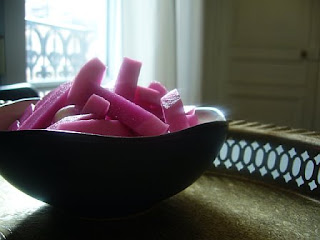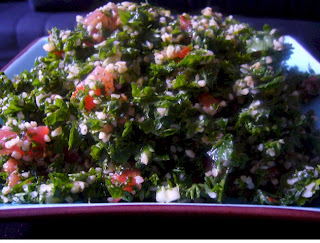 Let's get down to the basics.
Let's get down to the basics.
If you have any Middle Eastern roots, have traveled through the region, or been to any party of hosts who are of Middle Eastern origin then you have had meals that start with mezze. Mezze is like the appetizer portion of a meal. It is made up of a variety of usually pita-dippable spreads and salads that should be served family style. Often they serve as a meal itself.
Hummus is a requisite for a complete mezze. It is also the best known and the quickest to prepare.
Hummus
When I was in Tel Aviv last year, colleagues took me to a hummus restaurant. This type of restaurant serves only hummus. They offer a series of variations to the concoction - simple hummus with a little bit of olive oil, with a topping of whole chick peas sautéed or baked with spices, and even with a super hard boiled egg (the kinds they let simmer over a burner all through shabat). Given that hummus is one of my favorite foods, I was pretty happy at that restaurant.
The last time I was in New York, I noticed a few hummus bars opening up in the Upper West Side. This comes as no surprise since hummus has been a trendy food in the States for some years now. But if I hear Rachel Ray or Bobby Flay call any bean puree hummus one more time....
Hummus is basically chickpeas (aka garbanzos, pois-chiches) pureed with tahine (sesame paste), olive oil, garlic, lemon and cumin. And every hummus maker and eater has their own preference of how much each ingredient should stand out. Some people like it heavy on the garlic, some heavy on cumin, others like it very simple (just tahine and chickpeas please). Culture has a lot to do with it. For example, in Israel the hummus didn't have cumin in it and very little garlic. In Syria and Lebanon, however, these spices are absolutely necessary.
I like it flavorful but not overbearing. I will share my formula and you can give it a try as is. A bit of advice is to add in the ingredients in order of your comfort or taste. You add a little bit of the first ingredient, whizz, taste, if you can handle more, go to the next step. Second bit of advice, if you’ve got one (and if don’t you should consider getting one) use a hand immersion blender. They come in so handy for hummus, soups, and anything that needs to be pureed. I love it, especially since I don’t have space for blenders and food processors.
You can use dried chick peas and let them soak overnight then boil them. Or you can just pick up cans of pre-boiled chick peas and have them ready and waiting in the pantry for spur of the moment hummus. Yes, it might taste better if you boil the chick peas yourself - but I really don’t think the taste difference is worth all that extra time and preparation. I should warn you now – I am not that kind of cook – the kind that has to do everything form scratch. No thank you. I’d rather go for a walk, have a little more time with friends, take an extra 10 minutes in bed before getting up….
Ingredients
Serving 4 for mezze or 2 for lunch
1 16 oz (425 ml) can of chickpeas / garbanzos / seeser /pois-chiches
1 ½ tbsp tahine (easily found in most major supermarkets these days, but you can also find it at Middle Eastern specialty stores)
1 tbsp olive oil plus for garnish
2 crushed cloves garlic
Half a lemon
1 tsp cumin
½ tsp salt
Drain the can of chick peas, rinse them and then drop them in a pot of boiling water for 2 minutes. Drain the chickpeas and rinse again. Let them cool. This will cut down some of the “bean” effect but if you don’t have the time for the boiling and cooling part (5 minutes), at least rinse them out well.
Put the chickpeas in a medium mixing bowl. Add the tahine, olive oil, garlic, lemon, cumin and salt. Remember, you can always add more of each later according to your taste, so start out by adding half of the ingredients. Puree until you get a nice spread-able, dip-able paste. Taste and add more of each ingredient as you see fit. Experiment until you get the taste you like. If the hummus is too thick, add a tablespoon of water.
Spread onto a plate or a shallow bowl. Garnish with a swirl of olive oil, sprinkling of cumin and red pepper, and an olive or the top of a sprig of mint in the center. Serve with pita bread. Smile.







